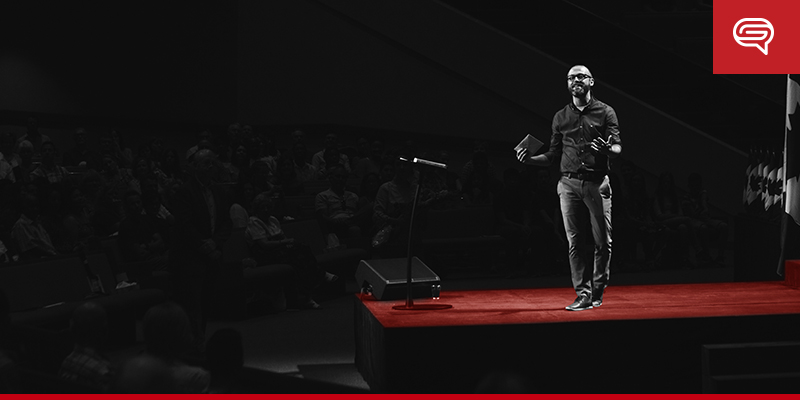
Try going a day without sharing a story.
Sound impossible?
Stories are an intrinsic part of our experience as humans. They’re a vital part of how we communicate with one another.
That said, if storytelling is so essential to our daily lives, why do so few harness it in their presentations?
When we address an audience, we tend to focus on the important points we need to convey. We talk about data or explain a business model.
We concentrate on information that’s crucial to the outcome we’re hoping for. Yet despite this, we still forget to answer why everyone in the room needs to hear what we have to say.
Your presentation content has to be more than just a barrage of information and numerical data.
This is where presentation storytelling comes in handy—there’s nothing more compelling than a good story.
Just ask Dr. Zak, who carefully explains how the human brain responds to effective storytelling in this video:
Pretty cool, right?
The effectiveness storytelling lies in how your audience reacts to it.
As social beings, we’re naturally attuned to our emotions. It doesn’t matter whether it makes you sad, happy, angry, or nostalgic — our brains love a good story.
This is something TED presenters have capitalized on.
If you review the list of the most viewed TED Talks, you’ll see each of them has a story integrated into the discussion.
As Forbes contributor Nick Morgan points out:
“No matter how interesting the information, you’ll run up against the limitations of the brain and quickly overtax your audience. If instead you tell your audience a story, you get to jump right into the deeper parts of their brain, where emotion and memory work together — the hippocampus and amygdala.”
So the importance of storytelling can’t be overstated, but what can integrating a story arc do for your business presentations?
1) They Make Your Messages More Relatable
There’s a reason many of us filled our notebooks with doodles during our school days.
Facts and figures can make any lecture boring and mind-numbing.
When incorporating storytelling, the right stories can make your message more meaningful and—most importantly—digestible.
This is especially true if you take the time to understand your audience and the type of life stories that will grab their attention.
2) They Help You Connect with Your Audience
Stories can help establish a bond between the storyteller and the audience.
They cut through the audience’s filter better than facts, giving you a greater chance of garnering more meaningful attention, earning their trust, and — ultimately — consuming your message.
Once you have a connection with your audience, you can have them hanging on every word you say.
3) They Make Your Audience Agree with You
When stories hit their mark, they can add a greater impact to your presentations, making it easier for the audience to agree with your points.
This happens because stories shut down whatever counter-arguments your listeners have, making them less likely to develop reasons to disagree.
Integrating Storytelling in Business Presentations

What is business storytelling?
According to Mike Murray, business storytelling is about “brands sharing their messages in ways that engage audiences and drive them to a desired action.”
This might sound like content marketing, but Murray maintains that the two separate, but related, things ideas:
“Business storytelling is a distinct content discipline that leverages well-crafted narratives in a diverse range of content types. Content marketing is much broader and speaks to the collective efforts that companies use to communicate with their audiences in an informative and engaging way.”
But how does one integrate storytelling into a business presentation?
Actually, it’s pretty easy to create a heart-warming story for a presentation. The real challenge is turning data into a narrative that packs an emotional punch.
First, Structure Your Presentation Like a Story
According to presentation storytelling expert Bruce Gabrielle, you’ll need to follow a simple but effective structure: Beginning, Middle, End.
Beginning: The Human Element
Start your presentation by letting your audience see there’s a genuine and relatable story behind what you’re presenting.
For example, identify a hero that your audience can relate to instead of leading with numbers or graphs. There is always a face behind all the abstract concepts and issues you’re taking on and that face will allow your audience to relate your topic to their own experiences.
Substitute “what” with “who do I really want to talk about?” For example, if you’re trying to discuss a marketing strategy, your hero could be a potential client. Describe the person you want to engage with your services. Talk about their demographics, traits, and values.
Middle: The Conflict
What would your favorite movie be like without conflict?
Like any good story, business presentations also need a bit of tension. Apart from his or her goals, you also have to identify the challenges and risks faced by your hero.
What are the things that bother your potential clients? What’s preventing them from engaging with your services?
End: The Resolution
After building conflict, offer your audience some reprieve by giving them a satisfying resolution.
At this point, you can put everything together and focus on data necessary to your discussion. While explaining the graph on your slides, keep referring back to your hero. What do these numbers have to do with the hero of your story? How does it solve the problems you identified earlier?
One thing to note is that although using stories in presentations will provide more impact, try to make use of captivating visuals, as well. While your narrative is certainly the most important part of your presentation, visuals remain to be an effective way to enhance audience immersion.
Let’s Take This A Bit Further…

To elicit even more powerful emotions from your audience, craft a story that follows the solid structure Gustav Freytag first envisioned 150 years ago:
Exposition
In a literary story, this is where the author lays out some “ground work” by presenting the characters, setting, and basic conflict.
This is where you establish context for your presentation. Introduce the point-of-view you’re presenting and share some background information. If the story focuses on an experience you had with a client, set the scene and illustrate the important details.
Rising Action
After presenting the context of your story, it’s time to build tension and increase conflict.
Start identifying obstacles that prevent your character from feeling fully satisfied or happy. If your story is from a target customer’s POV, tell your audience about the challenges they face.
Climax
As the turning point of your story, the climax is the part where your character comes face-to-face with their problem.
This is where the conflict becomes fully-realized and a solution is seen on the horizon. For your presentation, the climax marks where you start driving home your core message.
Falling Action
Slowly, as a solution becomes clearer and clearer, your character takes a course of action towards the identified goal.
In the traditional sense, this is where the protagonist battles the antagonist. For your presentation, this is where you further flesh out your core message, expounding more on how it helps resolve the problems you introduced early on.
Conclusion/Resolution
Finally, describe how your character meets their goals. This is where you explain how you and a difficult client came to an agreement. In another example, the conclusion is when your target customer finally achieves full resolution.
The Different Types of Business Stories

In literature, stories are told to reveal broader themes.
While you’re not expected to philosophize abstract themes in your presentation, the story you share should also have a purpose.
At its core, it should be more than just a story. Your narrative should be driven by a rationale that is essential to illustrating your presentation’s core message.
To get there, consider asking yourself these key questions:
- What is the main point you’re trying to get across?
- What is the underlying principle behind your presentation?
- What is the significance of this particular story?
The more you understand the key takeaway, the better you can deliver your presentation story.
In her book, “Whoever Tells the Best Story Wins,” Annette Simmons identified six kinds of stories that can help facilitate business communications:
- “Who am I” Stories
- “Why am I here” Stories
- Vision Stories
- Values-in-Action Stories
- Teaching Stories
- “I know what you’re thinking” Stories
(You can read about each story here.)
While Simmons uses these stories to help frame interactions that are more straightforward, her insights can also be helpful to marketing presentations.
Particularly, it’s the first three that are important to presentation storytelling.
These are the type of stories that help reveal insights to build trust and establish rapport between you and your audience.
Obviously, you won’t be telling stories from your own personal experience. Instead, think of answers to “Who am I?”, “Why am I here?” and “What do I envision?” in terms of your brand and company identity.
Here are a few specific questions, courtesy of Content Marketing Institute, to help you narrow it down:
- What’s your reason for being?
- What’s your history?
- Who are your main characters?
- What’s your corporate mission?
- How have you failed?
Humans have always been storytellers. It’s our way of connecting with each other.
In whatever form, the core of all our communications is the primordial impulse to tell and hear stories. Why not use that to improve your presentations?
A Tale as Old as TED

As mentioned earlier, TED speakers are some of the best people to ask about storytelling tips.
Human rights attorney and public speaker Bryan Stevenson has received the longest standing ovation ever given at a TED Talk.
In March 2012, Stevenson held a TED Talk called We Need to Talk About an Injustice. He talked about his grandmother and other people in his life, allowing him and the audience to establish a personal connection.
What made it successful was its emotional arc—a compelling story of overcoming a relatable struggle. If you don’t have a personal experience to share with your audience, tell them stories about real people—previous customers that have benefited from your company. Relevant real-life case studies are irresistible because the audience knows these are from other customers and not just opinions based on your thoughts alone.
Does your brand have an interesting origin story? This could be engaging and entertaining, like Airbnb’s—three guys making a few bucks by letting attendees at a local conference sleep at their place.
Not only did this pay for the steep rent, but it also sparked a $30 billion-dollar idea.
TED Talks have stood out as an effective medium because it provides extensive information that’s easy to understand.
But what else makes TED Talks special?
Carmine Gallo boils its core elements down to three. He notes that the success of these presentations can be attributed to these three qualities:
- Emotional
- Novel
- Memorable
Apart from these, top quality visuals are also necessary in engaging the audience. Consider consulting with PowerPoint presentation experts, it will prove a valuable step in the long term, especially for sales pitches.
The Other Half of Effective Presentation Storytelling: Visual Aids

So what about your presentation’s visual aid (typically a PowerPoint)? Should you bolster your narrative with visuals?
Humans are highly visual creatures. We’re naturally attracted to beautiful colors and interesting patterns.
In fact, our brain is able to process images 60,000 times faster than information presented in text. It’s also easier for us to retain visual information.
According to Dr. John Medina, after three days, we’re able to recall 65% of information if it was presented with images or illustrations.
So if you’re presenting information that’s bulky with data, the audience will thank you if you can integrate comprehensible illustrations. Take the usual charts and graphs a step further by weaving stories through imagery.
Let’s take a look at some facts.
According to a whitepaper published by NewCred and Getty Images, the following statistics are proof:
- 40% of people will respond better to information presented visually
- 83% of human learning is visual
- 44% of users are more likely to engage with brands on social platforms if they post pictures
Articles and blog posts that contain images get 94% more views than those without
It’s easy to see why images are important to presentations and marketing materials.
Through visual storytelling, you can create stronger emotional impact. Visuals convey a story that immediately allows your audience to connect with the message you’re sharing.
So whether you’re delivering a presentation or revamping your social media profiles, visual storytelling is the best way to go.
When selecting pictures to use, try to keep in mind the four key characteristics of visual storytelling:
Authentic
The best stories come from candid moments.
It’s why photo sharing has become so prevalent in the age of social media. Replacing the super-polished stock photos are snapshots that allow others to see the world through a more personal perspective.
Take, for example, Dove’s Real Beauty campaign. Instead of featuring models that are photo-shopped to perfection, Dove featured everyday women and challenged today’s absurd beauty standards.
To find images that are more authentic to your story, focus on what your brand stands for. Look for images that convey your identity and experiences as a brand. Next, look for something that will resonate with your audience.
Think about the people you’re addressing and what might be authentic for them.
Relevant
Visual storytelling should also take into account what’s happening in the world.
After all, your message doesn’t exist in a bubble.
It’s contextualized in a milieu—a world where billions of individuals are discovering new things every single day. Make sure your visual stories are relatable and relevant to the audience you want to target. Consider what Oreo did to make the most out of a blackout that interrupted the Super Bowl.
For your own visual story, choose images that evoke a sense of time and culture.
Sensory
The only thing better than a picture is the real thing.
But since you can’t have real situations on a PowerPoint slide, you’re going to have to settle for the next best thing. Visual storytelling thrives on imagery that can heighten emotions and senses.
Close-up and macro shots are great for showing textures that audiences can almost touch. On the other hand, a long shot can also take your audience into a particular scene, allowing them to experience it through a wider perspective.
Archetypal
Lastly, the best of visual storytelling alludes to narratives that are practically as old as time.
If you think about it, you’ll notice that all your favorite stories are tied together by recurring themes and archetypes.
These are universal symbols—called such because they can be found across many different countries and cultures. For your visual stories to be a success, you need to take these symbols and turn it into your own.
Find an archetype that relates to your brand and make it your own. Get to know your own new character and find images that correspond to this new version of a well-loved symbol.
Visual storytelling is a great technique to use in presentations and marketing efforts. By weaving imagery together, you can create a story that speaks volumes about your core message.
Integrating Visuals to Enhance Your Core Message
There’s more to visual storytelling than sticking random pictures to your slides. You can probably guess what we mean by “visual storytelling:”
- High-quality, relevant imagery
- Eye-catching animation
- Video
- Data visualization
Your statistics won’t make much sense if the visuals you add only serve an aesthetic purpose. Visual storytelling is about using different media that contribute to the message you’re presenting.
As an example, here’s a small part of an interactive infographic by Collaborative Fund, Hyperakt and Start Up American Partnership:
The infographic showcases the positive effects of car sharing to the environment.
It offers a lot of statistics that are perfectly illustrated to create more impact. It’s hard to envision the difference a vague number makes but through this illustration, you can perfectly see how much carbon dioxide emissions have diminished.
Related: Mastering Data Visualization for High-Stakes Presentations
Your text-based, bullet point-ridden PowerPoint design isn’t helping anyone. It’s not engaging your audience, and it’s not helping you get your message across.
Instead, you should consider taking inspiration from visual storytelling. Showcase and illustrate your key points with visual elements, and your PowerPoint design will have more impact.
Hopefully this post has conveyed the importance of storytelling in presentations from both the aural and visual perspectives. Ready to take your next high-stakes presentation to the next level? Schedule a free presentation consultation!





